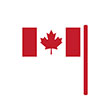The history of Canada Day
Canada Day is a day to reflect on what it means to be Canadian, to share what makes us proud and to celebrate in our own way. This pride is reflected in as many ways as there are Canadians.
Canada Day highlights the richness of our land, our diversity, our culture, our contributions, but above all, our people. Since 1868, July 1 is an opportunity for Canadians from all communities to come together.
The creation of Canada Day
July 1, 1867: The British North America Act (today known as the Constitution Act, 1867) creates Canada.
June 20, 1868: Governor General Lord Monck signs a proclamation that requests all Her Majesty's subjects across Canada to celebrate July 1.
1879: A federal law makes July 1 a statutory holiday as the "anniversary of Confederation," which is later called "Dominion Day."
October 27, 1982: July 1, "Dominion Day" officially becomes Canada Day.
The celebrations start
July 1, 1917: The 50th anniversary of Confederation. The Parliament buildings, under construction, are dedicated to the Fathers of Confederation and to the courage of Canadians who fought in Europe during the First World War.
July 1, 1927: The 60th anniversary of Confederation. The Peace Tower Carillon is inaugurated. The Governor General at the time, Viscount Willingdon, lays the cornerstone of the Confederation Building on Wellington Street.
From 1958 to 1968: The government organizes celebrations for Canada's national holiday every year. The Secretary of State of Canada is responsible for coordinating these activities. A typical format includes a flag ceremony in the afternoon on the lawns of Parliament Hill and a sunset ceremony in the evenings, followed by a concert of military music and fireworks.
July 1, 1967: The 100th anniversary of Confederation. Parliament Hill is the backdrop for a high-profile ceremony, which includes the participation of Her Majesty Queen Elizabeth II.
From 1968 to 1979 (with the exception of 1976): A large multicultural celebration is presented on Parliament Hill. This concert is broadcast on television across the country. The main celebrations (called "Festival Canada") are held in Canada’s Capital Region throughout July. These celebrations include many cultural, artistic and sport activities, and involve the participation of various municipalities and volunteer associations.
From 1980 to 1983: A new format is developed. In addition to the festivities on Parliament Hill, the national committee (the group tasked by the federal government to plan the festivities for Canada's national holiday) starts to encourage and financially support local celebrations across Canada. Start-up funding is provided to support popular activities and performances organized by volunteer groups in hundreds of communities. Interested organizations can make a request under the Celebrate Canada program.
1981: Fireworks light up the sky in 15 major Canadian cities, a tradition that continues today.
1984: The National Capital Commission (NCC) is given the mandate to organize Canada Day festivities in the capital.
2010: Festivities on Parliament Hill receive the royal treatment when Her Majesty Queen Elizabeth II and His Royal Highness The Duke of Edinburgh join the festivities to celebrate Canada's 143rd anniversary.
2011: Their Royal Highnesses Prince William and Catherine, The Duke and The Duchess of Cambridge, participate in Canada Day festivities on Parliament Hill on the occasion of Canada's 144th anniversary.
2014: Canadian Heritage organizes the 147th Canada Day celebrations. As we approach Canada's 150th anniversary in 2017, the government has given the Department the mandate to organize Canada Day festivities in the capital.
2017: A wide range of activities are held across the country to mark the 150th anniversary of Confederation. Attending Canada Day for the first time, The Prince of Wales and The Duchess of Cornwall join in the festivities on Parliament Hill to mark this milestone anniversary with Canadians.
2020-2021: Due to the COVID-19 pandemic, the celebrations are presented in virtual format to comply with public health guidelines.
2022: Canada Day celebrations are back in person in Canada’s Capital Region. Although Parliament Hill has been the official site of our national holiday for more than 50 years, the main stages are moved to new locations given the renovations to Parliament. The festivities are held mainly at LeBreton Flats Park and in the heart of Ottawa-Gatineau.
2024: After many decades, Canada Day gets a new logo. Inspired by the National Flag of Canada and its history, the maple leaf appears at its most iconic — in a magnificent display of warm colours. Within the logo, the veins create images, notably those of fresh buds emerging with renewed life. The paths they travel and the points where they connect shape our vision for a greater future.

Celebration kit
- Download digital and visual promotional tools to share your Canadian pride and show your colours!

Playlist
- Tap into the spirit of Canada Day with the official playlist.


